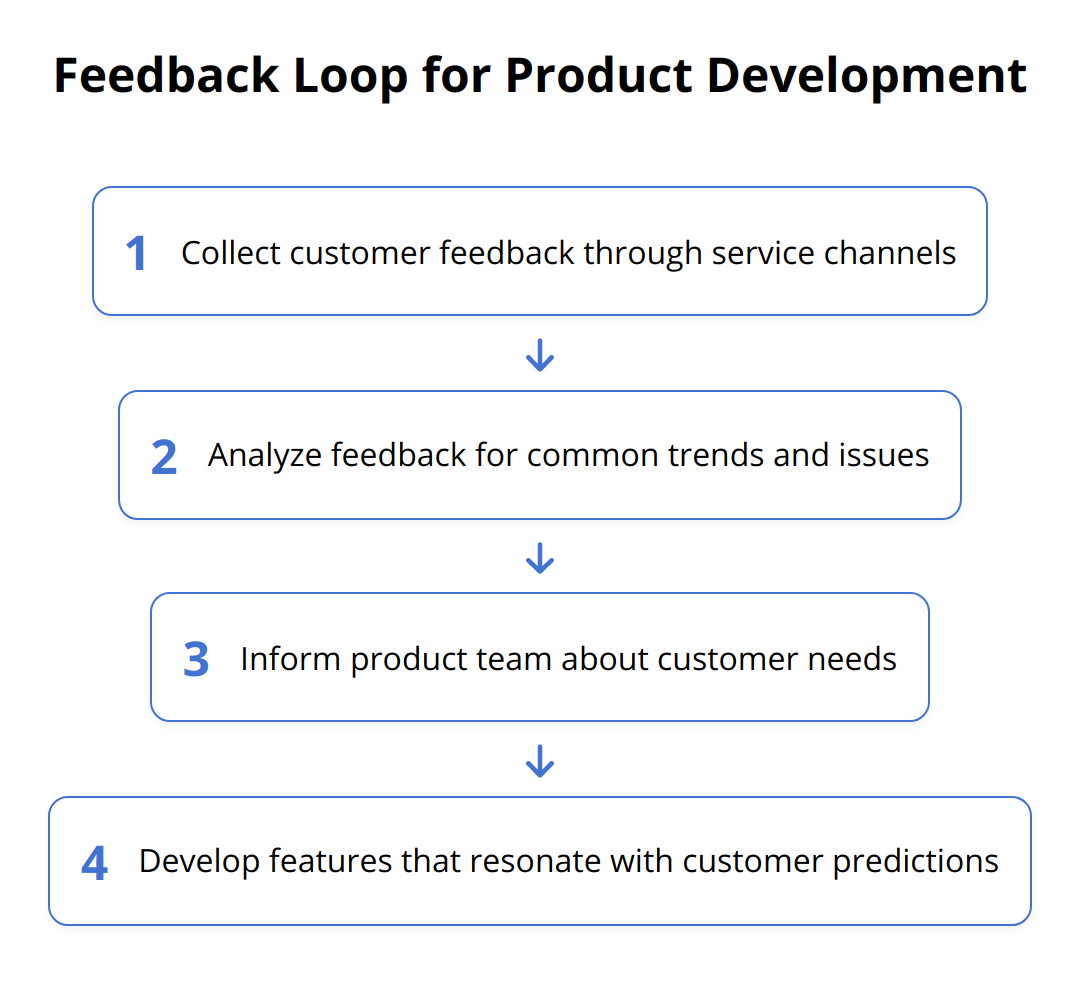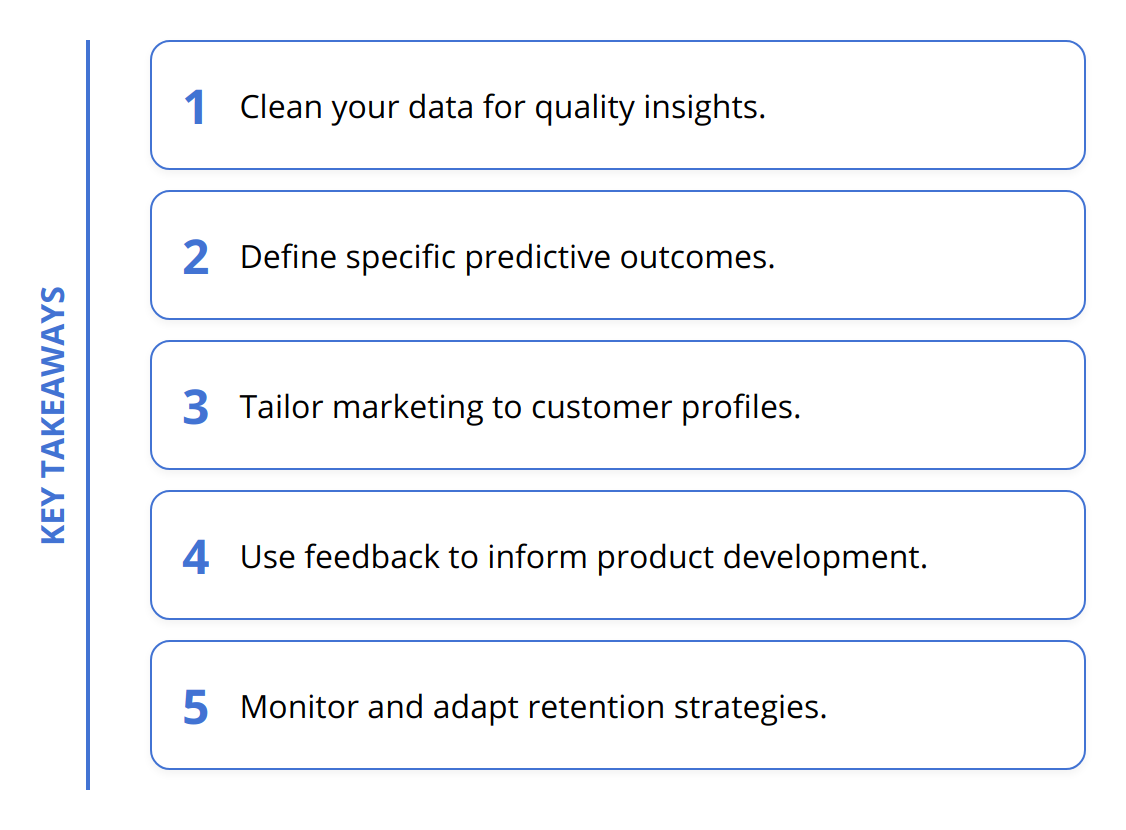Predictive customer segmentation is transforming how businesses approach their markets. By identifying which groups are most likely to engage or purchase, organizations can tailor their strategies with unparalleled precision.
We at Emplibot recognize the game-changing potential of this approach. This blog post aims to guide your business through harnessing the power of predictive analytics for sharper customer segmentation.
Harnessing Predictive Analytics for Segmentation
Predictive analytics in customer segmentation is steeped in data to forecast future behavior. This method pinpoints patterns in customer data to highlight who is most likely to make a purchase or engage with your brand. The idea is simple: use historical data to predict future outcomes. But the practice is methodical and requires a sophisticated touch.
The marketing DNA of your brand thrives on targeting the right audience. Predictive customer segmentation serves up detailed insights into customer behavior, significantly enhancing marketing strategies. A major benefit is the allocation of marketing resources. By predicting which customer groups are most lucrative, businesses can focus their efforts—and budgets—more effectively.
Sales strategies get a powerful upgrade with predictive analytics. It’s like having a crystal ball that helps anticipate customer needs. Companies that utilize predictive customer segmentation can craft personalized outreach, knowing when and how to approach potential clients for increased chances of conversion.
The customer experience also significantly benefits from predictive segmentation. Let’s lay out the facts:
-
Customers are 40% more likely to purchase from companies that engage them with personalized experiences, according to an Infosys survey.
-
A study by Econsultancy found that 94% of companies report that personalization is critical to current and future success.
Providing a personalized experience isn’t just about knowing your customer’s name; it’s about anticipating their needs and knowing their preferences before even they do. That’s where predictive customer segmentation steps in. It allows businesses to customize the customer journey at every touchpoint for a sleeker, more enjoyable experience.
In practice, a company might analyze purchase history, website navigation patterns, and social media engagement to segment customers likely to be interested in a new product line. These insights can fuel marketing automation strategies to deliver highly relevant content that resonates with each segment.
Using predictive analytics for segmentation isn’t a silver bullet—it’s a tool that needs to be wielded with skill and care. Here are some practical guidelines:
-
Start with clean, well-organized data; the quality of insights depends on the quality of input.
-
Define the outcomes you want to predict, like churn rate, lifetime value, or purchase likelihood.
-
Continually refine algorithms and models as new data comes in to maintain accuracy.

The key takeaway for businesses is that predictive customer segmentation is not about narrowing focus but about sharpening it. With the aid of predictive analytics, your engagement strategy can be both broad and deep, ensuring that no potential customer feels left out, and no marketing dollar is wasted chasing indifferent leads.
Predictive customer segmentation is a launching pad for targeted actions, not just targeted messaging. That’s what makes it indispensable for businesses looking to streamline their approach and deliver more value with every customer interaction. Implement these insights, and you’ll not only meet customer expectations—you’ll consistently exceed them.

Elevating Conversion Rates
Tailoring marketing initiatives to match customer profiles generated by predictive analytics can dramatically lift conversion rates. Organizations equipped with this foresight can craft campaigns that hit the mark every time, offering the right products to the right people at the right time.
Here’s the lowdown: predictive models analyze customer behavior, identifying those most receptive to your offerings. Armed with this information, marketing campaigns can be fine-tuned to target these high-potential groups, increasing the efficiency of marketing spend and boosting conversion rates. If you ensure that the messages resonate deeply with the audience’s predicted needs, interests, and behaviors, your conversion rates can climb significantly.
Moreover, conversion optimization doesn’t stop at the first purchase. Predictive analytics can also indicate which customers are ripe for upselling or cross-selling opportunities, giving you an edge in maximizing the customer lifetime value.
Consider this: by deploying focused email marketing, campaigns directed at segments identified as high-conversion prospects yield engagement rates beyond the industry standard. Further insights from predictive segmentation can also pinpoint optimal times for sending communications, leveraging email automation to its fullest potential.

Refining Product Development
Predictive segmentation informs your product development teams about evolving customer needs and preferences. By understanding the distinct characteristics of each segment, businesses can tailor their product offerings and create bespoke solutions that speak directly to customer pain points.
Statistics demonstrate the power of data-informed product development. A report by Pragmatic Institute showed that 80% of new products fail because of a lack of customer insights. With predictive segmentation, you’re equipping yourself with a valuable tool to buck this trend.
Here’s a practical move: initiate a feedback loop between your customer service channels and product development team. Leveraging insights from one-on-one interactions, you can identify common issues and trends which can then inform future product enhancements or innovations.
Predictive data can also help prioritize which product features to develop next, by forecasting which additions will resonate most strongly with your audience and drive further engagement.

Cultivating Loyalty and Retention
Customer acquisition is just one part of the business equation; retaining those customers is what sustains growth. Predictive customer segmentation offers vital clues for enhancing customer loyalty and discouraging churn.
By predicting which customers may need extra attention to stay engaged with your brand, targeted retention strategies can be deployed before it’s too late. For instance, if data indicates a segment is showing decreased engagement, that could trigger special offers or loyalty rewards aimed at reinvigorating their interest in your brand.
Statistics show the impact of predictive segmentation on retention: increasing customer retention rates by as little as 5% can lead to an increase in profits from 25% to 95%, according to research from Bain & Company.
Fast tips for boosting retention with predictive customer segmentation:
-
Monitor warning signs of churn, such as a dip in purchase frequency or social media engagement.
-
Create custom re-engagement campaigns designed specifically for segments that are at risk of falling away.
-
Offer personalized promotions based on each segment’s purchasing patterns to foster a sense of valued individuality.
In conclusion, predictive customer segmentation has the potential to revolutionize the way you attract, engage, and retain customers. By harnessing the power of predictive analytics, your business can deliver targeted marketing, fine-tune product development, and increase customer loyalty and retention levels, setting you apart from the competition.
Achieving Precision in Customer Insights

Integrating predictive analytics into your customer segmentation strategy requires a solid foundation built on high-quality, relevant data. The path to precision in forecasting customer behavior and effectively applying predictive models begins with gathering, analyzing, and acting upon the right set of customer data.
Gathering and Utilizing the Right Customer Data
The process starts with data collection: meticulous and systematic. You have to pull information from various touchpoints — be it your CRM, social media analytics, or customer feedback forms. But more important is ensuring data relevance and quality. Irrelevant data can mislead predictive models, so vet your sources carefully and ensure they align with your forecasting goals.
Consider blending transactional data with interaction data for a 360-degree view of the customer. For example, someone’s purchase history, combined with their engagement on your customer service platform, can provide a comprehensive picture of their habits and preferences.
Methods and Tools for Analyzing Customer Behavior
Once you’ve got a robust dataset, the next step is analysis — and this is where the real work begins. Utilize data mining tools and advanced analytical platforms that offer features like regression analysis, clustering, and decision trees to identify patterns and correlations in customer behavior. These tools often come embedded in marketing automation systems, which can seamlessly apply the findings to customer outreach strategies.
To get actionable insights, look at past buying cycles and engagement patterns. Determine what drives high-value customers to your business and which behaviors signal an impending churn. Tools that can handle complex datasets with multiple variables will give you the advantage here, enabling you to craft truly predictive customer profiles.
Best Practices for Applying Predictive Models to Segmentation
When it’s time to apply your predictive models to segmentation, start with clear objectives. Define what success looks like in relation to your business goals, whether it’s increased retention, higher conversion rates, or more effective upselling. Then, incorporate these best practices:
-
Establish a feedback loop from your campaign results back into your model. Refining your approach with real-world outcomes keeps your segmentation strategy sharp and relevant.
-
Regularly update your models with new data. Customer behaviors and market conditions are constantly evolving; your models should evolve too.
-
Prioritize transparency and interpretability in your models. Predictive analytics is powerful, but being able to explain the ‘why’ behind predictions is vital to maintain trust and alignment with business strategies.
Remember, predictive analytics is a powerful enabler for personalized marketing that can lead to impressive conversion lifts, as highlighted in our discussion on tailoring marketing initiatives.
Here are some quick, impactful actions to make sure your predictive analytics integration thrives:
-
Automate data cleaning to reduce errors and save time
-
Pinpoint key predictive indicators specific to your industry and audience
-
Visualize data trends and share them across teams for unified decision-making
In short, the integration of predictive analytics is a fine balance of science and strategy—data rigor paired with business acumen. By focusing on precise data collection, utilizing advanced analytical tools, and applying best practices in your models, your business can leap towards more accurate customer understandings, leading to better business outcomes and a competitive edge in your market.
Gauging Predictive Segmentation Impact
Evaluating the effectiveness of your predictive customer segmentation is essential for understanding the true impact on your business. Measuring the outcomes not only helps in validating the approach but also provides critical insights that can shape future strategies. The power lies in identifying the right metrics that correlate strongly with your business objectives and can tell you where to double down or course-correct.
Determining Success with Strong KPIs
The first step is pinpointing Key Performance Indicators (KPIs) that matter. KPIs for predictive segmentation vary from traditional ones because they relate directly to forecasted behaviors. Here are the KPIs that demand your focus:
-
Segment Growth: Observing whether segments identified as high-potential are actually expanding.
-
Engagement Rates: Checking if the targeted segmentation leads to increased interaction across your channels.
-
Conversion Increment: Comparing present conversion rates with those prior to implementing predictive segmentation strategies to gauge incremental growth.
-
Cost Per Acquisition (CPA): Monitoring if CPA is decreasing within your forecasted segments due to more precise targeting.
Boosting Customer Lifetime Value
Customer Lifetime Value (CLV) improvements signify that you’re not just acquiring one-time buyers but nurturing profitable long-term relationships. Analyze your segments’ CLV by tracking revenue per customer post-segmentation against the initial acquisition costs. Businesses that recognize a considerable uptick in CLV often can attribute that success to precise predictive segmentation that enhances upselling and cross-selling tactics.
Valuing Feedback and Agility
Incorporate customer feedback collection as an integral part of assessing your predictive segmentation’s success. High satisfaction rates and low complaint frequencies within targeted segments can signal your predictions hit the mark.
Most importantly, adaptability is key. Your business must remain agile, using the collected data and feedback to refine future approaches. What works today may not work tomorrow; the beauty of predictive analytics is its inherent flexibility to adapt to changing patterns.
Quick Adaptation Guidelines:
-
Observe short-term trends but be wary of anomalies. Regularly revisiting and reassessing segment behaviors help in recognizing shifts in trends.
-
Listen closely to direct customer feedback, as well as churn signals to adjust your engagement strategies promptly.
-
Regularly experiment with segment-specific approaches to discover what yields the best response.
The end goal is to create a predictive customer segmentation machine that is self-improving, harnessing real-time data and feedback to constantly enhance its accuracy. When predictive analytics is treated as an ongoing, iterative process, businesses position themselves for sustained growth and resonance with their markets. Look beyond the numbers to the stories they tell about customer interactions with your brand—those narratives are where true strategic adjustments can be made.
By zeroing in on well-defined KPIs, assessing CLV enhancements, and being ready to pivot based on customer feedback, your business gains a considerable edge. You transition from casting wide nets in hopes of catching something to a strategic player who knows where the fish are biting. This precision gives your company an invaluable edge in the competitive world of business.
Remember, predictive customer segmentation is not just about creating segments; it’s about understanding them deeply enough to drive business results effectively. For more insights on refining customer experience with predictive analytics, explore how marketing automation blends into the equation.
Wrapping Up
Predictive customer segmentation is more than a marketing tactic; it’s a strategic advance that empowers a business to act with confidence in a data-driven marketplace. We’ve discussed how leveraging predictive analytics sharpens segmentation, thereby optimizing marketing resources, boosting conversion rates, refining product development, and increasing customer loyalty. Let’s summarize the transformative potential this approach brings to businesses.

Key insights include:
-
Predictive analytics deliver actionable insights, enabling businesses to proactively meet customer needs.
-
Personalization based on predictive models can lead to a substantial increase in sales and customer satisfaction.
-
Businesses can make informed decisions about product development and marketing strategies, reducing the risk of failure.
-
A focus on data quality and relevance is paramount for accurate predictive customer segmentation.
-
Adoption of predictive customer segmentation sharpens marketing strategies, leading to more effective targeting and resource allocation.
Predictive customer segmentation paves the way for businesses to adopt data-driven decision-making. By integrating data insights into every facet of your operations, you can ensure that your marketing efforts are not only targeted but also highly efficient. The strategic advantage is clear: organizations that effectively employ these models can expect to see sustained growth and a significant return on their marketing investments.
For businesses ready to take this leap forward, embracing predictive customer analytics is a vital step. It offers a clear path to understand and anticipate the unique demands of your market sphere. As you translate data into strategy, your business moves towards a future where decisions are informed by solid evidence and customer insights.
We at Emplibot are committed to helping businesses thrive in a data-centric world. Our services ensure your WordPress site is continuously populated with SEO-friendly articles, enhancing your digital presence and engaging your audience. By automating your content marketing with Emplibot, your team can focus on utilizing these valuable customer insights to drive your business forward.
Predictive customer segmentation is not merely a buzzword; it is the backbone of successful customer interaction in the modern age. Businesses that harness this approach will not just stay ahead of the curve—they’ll define it. The future of marketing is precision, and with predictive analytics, your business is poised to meet it head-on. For an automated solution in maintaining a robust SEO strategy, consider implementing Emplibot to enhance your digital growth and keep your content strategy aligned with your business objectives.

